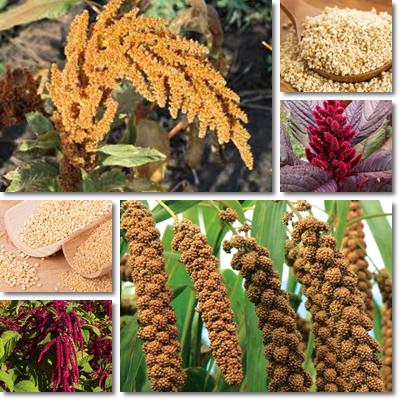The Aztecs called it the food of immortality while Indian folk beliefs recognized it as the king of grains. Amaranth (Amaranthus lineatus) is a pseudocereal of significant nutritional value as well as economic importance. In addition to being a good source of B vitamins, iron, magnesium, manganese, phosphorus and zinc, amaranth is rich in fiber and protein.
More important, it lacks gluten altogether, making it perfect for anyone struggling with gluten sensitivity, wheat allergy or Celiac disease.
Can you eat amaranth?
Amaranth seeds, greens, stems and roots from several varieties are edible. Officially, there are around 60 different amaranth species, the most notable of which are Amaranthus blitum, Amaranthus caudatus, Amaranthus cruentus, Amaranthus dubius, Amaranthus hypochondriacus and Amaranthus tricolor. The second, third and fifth are especially appreciated for their seeds. Depending on the variety, amaranth can be grown for edible seeds, leaves, stems or roots.

Amaranth seeds and greens (leaves) are by far the most popular culinary choices worldwide and the richest in nutrients. Traditional medicine recommends amaranth for disorders such as anemia or low red blood cells count, growth retardation in children (due to their good vitamin and mineral content), poor eyesight (amaranth leaves contain vitamin A), respiratory and ear infections, as well as recurrent colds. Also, amaranth consumption is recommended for people with hypertension (high blood pressure) and high cholesterol levels (due to its good phytosterol content).
What does amaranth look like?
Amaranth is generally a tall plant with tinsel-like light green, orange, pink, red or purple flower heads that either shoot straight up in a flame-shape or cascade like heavy tentacles on a burdened stem.
What do amaranth seeds and leaves look and taste like?
Amaranth seeds are creamy-white or light-brown in color and extremely small (around one millimeter). As far as taste is concerned, amaranth is pretty appetizing in the sense that it boasts a distinctive nutty flavor. Although cooked, the seeds remain somewhat crunchy on the outside and soft on the inside. Just remember to add 4 or 5 times more water than amaranth seeds when cooking them. Alternatively, you can pop the seeds in a hot pan and make a deliciously nutty amaranth popcorn.
Amaranth leaves, called greens, are broad and may be tinged with red or purple, in which case they may leave a color trail in your cooking water. While young leaves go well in salads, more mature one need to be cooked. Stir-fried, steamed or sauteed amaranth greens are soft and spinach-like.

What are the benefits of Amaranth?
Although it is a false cereal (pseudocereal), amaranth is genuinely healthy and can easily replace true grains like wheat in your diet. See below what are some of the most impressive properties and health benefits of amaranth:
Source of important amino acids
Rich in essential amino acids, amaranth promotes normal growth and development in children. Amaranth seeds contain important essential amino acids such as arginine, histidine, isoleucine, leucine, lysine, cystine, methionine, phenylalanine, threonine, tryptophan and valine. Juice left after boiling amaranth seeds can be given to children as a natural tonic drink. Mix it with honey for a more appealing taste.
Amaranth seed juice for respiratory infections
Amaranth is said to help treat respiratory problems such as chronic bronchitis, asthma, colds, flu and so on. Drink one tablespoon of fresh amaranth seeds juice with honey everyday until your problem clears. Time may vary from the start of the treatment until you begin to notice improvements in your condition.
Helps lower cholesterol levels
When consumed regularly and with moderation, amaranth seeds show cholesterol-lowering properties. Similarly, amaranth oil provides cardiovascular protection in individuals suffering from hypertension (high blood pressure) and coronary heart disease.
The reasons behind the heart-protective properties of amaranth are its high fiber content (6.7 g of fiber/100 g of uncooked seeds), impressive phytosterol and manganese content.
Fiber indirectly lowers cholesterol levels by inhibiting the absorption of fat in the intestines. Phytosterols are a sort of plant counterpart of cholesterol.
A high dietary intake of phytosterols limits cholesterol intake and absorption and thus contributes to lowering LDL (bad) cholesterol levels. Moreover, preliminary research links phytosterols to a reduced risk for Alzheimer’s Disease.
High content of manganese
Amaranth provides more than 150% of the RDA of manganese, a powerful antioxidant-mineral which combats free radical oxidative stress and helps maintain healthy arteries. This nutritional component found in amaranth promotes cardiovascular health.
Benefits for anemia
Amaranth is a reliable source of iron (more than 50% of the RDA of the mineral). Regular consumption contributes to recovery from anemia caused by iron deficiency. Including vitamin C rich foods in your diet or taking vitamin C supplements can help increase iron absorption substantially, contributing to improvement of anemia and associated symptoms.
Excellent source of protein
Amaranth is about 13% quality protein or complete protein, containing all 9 essential amino acids. This makes it ideal for whomever is adamant about leading a vegetarian or vegan lifestyle because it partially meets daily dietary protein needs.
Also, people with conditions such as wheat allergy, gluten sensitivity or intolerance or Coeliac disease who are also vegetarian or vegan may rely on pseudo-cereals such as amaranth (13 g), buckwheat (18 g) and quinoa (around 14 g) to supply them with good amounts of protein. WHO (the World Health Organization) recommends a 1:1 ratio combination of rice and amaranth for a good protein intake.
Gluten free
Amaranth lacks gluten altogether. If you are suffering from gluten sensitivity or intolerance, wheat allergy or Celiac disease, the you need to be on a gluten-free diet. Replace wheat, barley, rye, even malt-based beer with rice, amaranth, quinoa, buckwheat, millet, teff, sorghum and Montina (a rice grass from India).
See benefits of quinoa and benefits of buckwheat.
Serious dietary changes will keep the conditions manageable and prevent unpleasant, even hazardous symptoms such as bloating, nausea, vomiting, diarrhea, small intestine inflammation, extended abdomen, anemia, growth retardation in children, vitamin deficiencies, fatigue.
Nutritionally dense food
Amaranth is rich in B vitamins, iron, magnesium, manganese, phosphorus and zinc. Regular intake promotes good energy levels, anemia management, supports bone, teeth and heart health and helps prevent and reduce the severity of colds and other respiratory infections. However, it does not constitute a treatment for any of the mentioned conditions.
Benefits for eyes and the immune system
Amaranth greens are a great source of plant vitamin A, more exactly beta-carotene and other carotenes with vitamin A activity. Regular consumption ensures healthy mucous membranes at the level of the eyes, nose, mouth, throat, lungs and stomach, contributes to the immune response and skin health, good vision and healthy eyes. The green leaves are also a source of lutein and zeaxanthin, carotenoids without vitamin A activity, but which contribute to eye health and good vision, and have vitamin C with anti-inflammatory and immune-boosting benefits.
